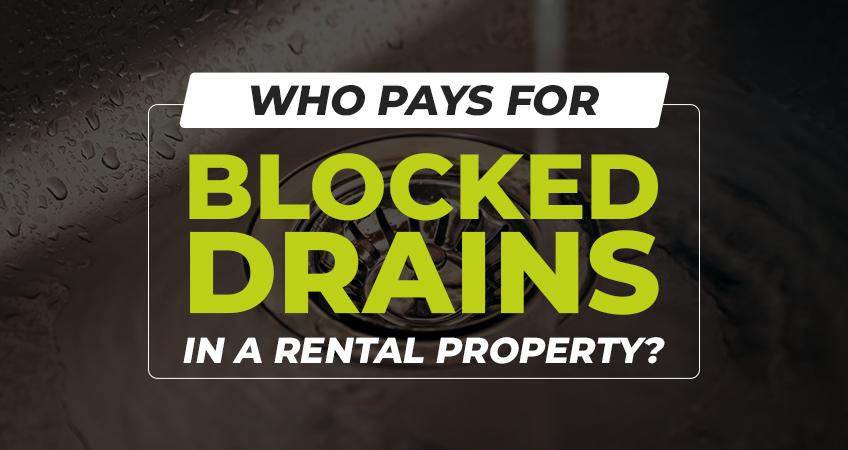When your rental property’s drain decides to stage a rebellion, the age-old question emerges: who’s reaching for their wallet? If you’re a tenant staring at a backed-up toilet or a landlord receiving frantic calls about mysterious gurgling sounds, you’re not alone. Over 35% of UK households now live in rental properties, making this one of the most common disputes between tenants and landlords.
The good news? We’re here to clear up the confusion (much like we clear your drains). As drainage specialists who’ve seen every imaginable blockage scenario, we understand that determining responsibility isn’t always straightforward. From sneaky tree roots to questionable flushing habits, the cause of your blockage often determines who foots the bill.
This comprehensive guide will help you navigate the murky waters of rental property drainage responsibilities, ensuring you know exactly where you stand when disaster strikes. Whether you’re a tenant wondering if your landlord should cover that emergency call-out or a landlord trying to protect your investment, we’ll break down the legal requirements, common scenarios, and practical solutions.
Understanding the basics of rental property drainage and who is responsible for blocked drains
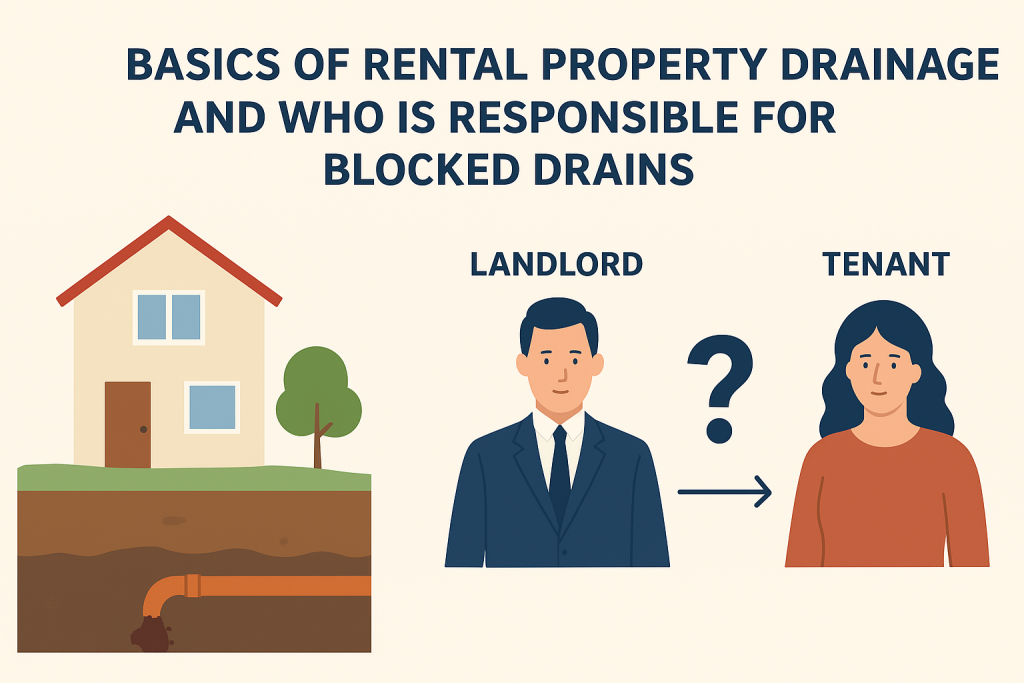
Before diving into who pays what, let’s establish the foundation of rental property drainage systems. Most rental properties fall into two categories: houses with private drainage systems and flats with shared drainage networks.
Houses typically have:
- Internal drainage (sinks, toilets, showers within the property)
- External drainage (pipes leading to the main sewer or septic tank)
- Private drainage systems that serve only that property
Flats usually feature:
- Internal drainage within the individual unit
- Shared drainage systems serving multiple properties
- Complex ownership structures involving freeholders and leaseholders
The Landlord and Tenant Act 1985 forms the backbone of drainage responsibilities in rental properties. This legislation clearly states that landlords must maintain drainage, pipes, and plumbing systems as part of their structural responsibilities. However, like most legal matters, the devil’s in the details.
Understanding whether your drainage system is private or shared significantly impacts who’s responsible for maintenance and repairs. We often use CCTV drain surveys to identify exactly where problems occur, helping determine whether the issue falls under landlord responsibilities or tenant obligations.
When it’s the landlord’s responsibility
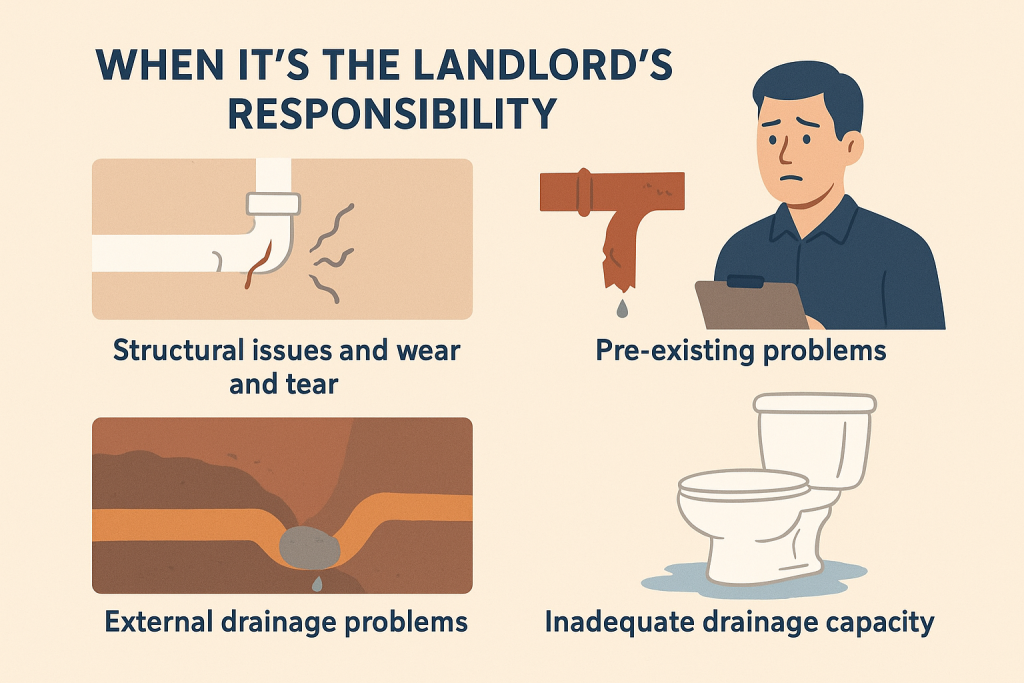
As drainage specialists, we frequently encounter situations where landlords are responsible for blocked drains in rental properties. The Landlord and Tenant Act 1985 makes it crystal clear: maintaining drainage systems, pipes, and plumbing falls squarely on the landlord’s shoulders in most circumstances.
Landlords are typically responsible when blockages result from:
Structural issues and wear and tear
Tree roots infiltrating pipes, collapsed drain sections, and general deterioration from age all fall under landlord responsibilities. We’ve seen centuries-old clay pipes finally giving up the ghost – hardly something a tenant could prevent or should pay for.
Pre-existing problems
When we conduct CCTV drain surveys, we often discover issues that clearly predate the current tenancy. Cracked pipes, poor installation, or inadequate drainage capacity aren’t tenant responsibilities.
External drainage problems
Blockages in drains outside the property boundary typically fall to the landlord. This includes main drain connections, shared pipes serving multiple properties, and drainage systems in communal areas.
Inadequate drainage capacity
Sometimes we encounter properties where the drainage system simply can’t handle normal usage. This might happen when a single-person property becomes home to a large family, revealing previously hidden capacity issues.
At Any Drains Direct, we provide comprehensive drain surveys specifically for landlords. These detailed assessments help property owners understand their drainage systems’ condition and identify potential issues before they become expensive emergencies. Our surveys include video footage and detailed reports, giving landlords the documentation they need for insurance claims or tenant discussions.
When tenants are responsible
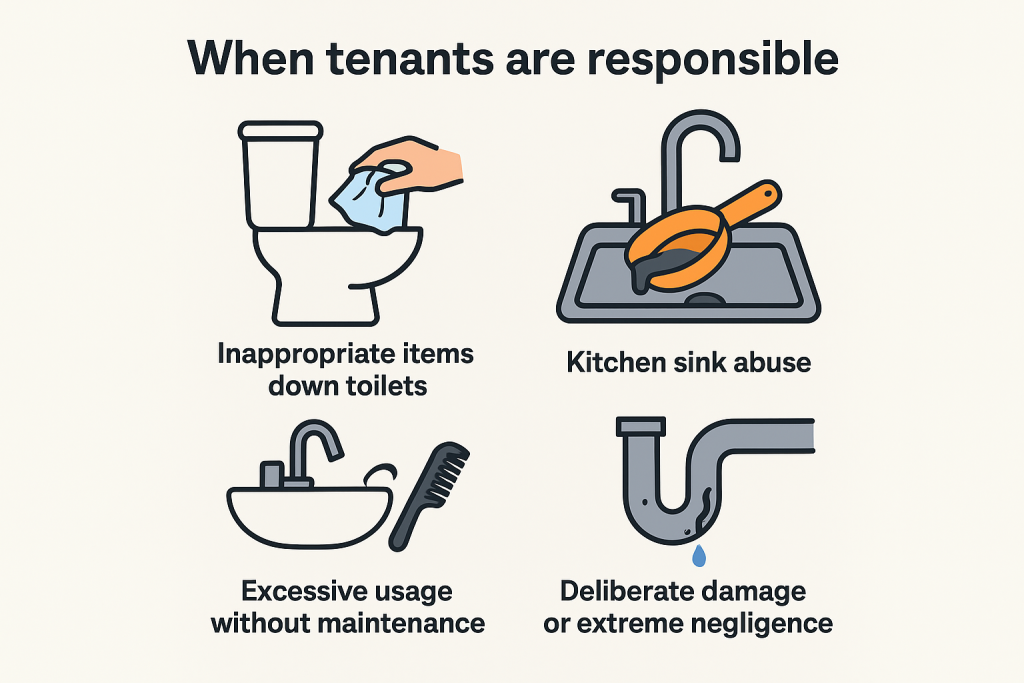
Now, let’s address the elephant in the room – or should we say, the wet wipe in the pipe? Tenants become responsible for blocked drains when blockages result from misuse or negligence. As drainage professionals, we’ve seen some truly creative ways people manage to block their drains.
Common tenant-caused blockages include:
Inappropriate items down toilets
Despite what manufacturers claim, wet wipes aren’t flushable. Neither are cotton buds, sanitary products, cat litter, nappies, or children’s toys. We’ve extracted everything from mobile phones to false teeth from blocked toilets – and trust us, none of these items improve with their underground adventure.
Kitchen sink abuse
Fats, oils, and grease are drainage system killers. That innocent-looking cooking oil might seem harmless when hot, but it solidifies in your pipes, creating concrete-hard blockages. Food scraps, coffee grounds, and rice also accumulate over time, creating stubborn obstructions.
Excessive usage without maintenance
Some tenants assume that if water goes down the drain, everything’s fine. However, hair, soap scum, and everyday debris gradually build up. While normal usage isn’t tenant negligence, completely ignoring obvious warning signs might be.
Deliberate damage or extreme negligence
We occasionally encounter situations where tenants have clearly damaged drainage systems through reckless behaviour. These cases are usually obvious and well-documented.
The key factor is proving misuse occurred. Smart tenants keep receipts for appropriate cleaning products and can demonstrate responsible usage. If you’re renting, document your drainage habits – it might save you money later.
Determining liability through investigation
Here’s where things get interesting – and where our expertise becomes invaluable. When a blocked drain occurs in a rental property, determining who pays often requires detective work. Simply finding a wet wipe in the pipes doesn’t automatically make the tenant responsible.
Our CCTV drain survey process reveals:
The primary cause vs. contributing factors
We might find wet wipes in a drain, but our camera also reveals extensive tree root damage. While the wet wipes contributed to the blockage, the underlying structural problem (landlord’s responsibility) created the conditions for the blockage to occur.
Timeline evidence
Our surveys can often determine how long problems have existed. Scale buildup, root penetration, and pipe deterioration develop over extended periods, usually predating current tenancies.
Blockage location
Where the blockage occurs matters enormously. Problems in shared drainage systems, main connection points, or external pipes typically fall to landlords or water authorities, regardless of what caused the immediate blockage.
System capacity issues
Sometimes we discover that drainage systems are simply inadequate for current use levels. A system designed for occasional use might struggle with daily family life – that’s not the tenant’s fault.
We provide detailed reports with video evidence, helping landlords and tenants understand exactly what happened. Our investigations are thorough, impartial, and documented – essential for resolving disputes fairly.
Many of our clients request these surveys specifically to avoid future arguments. Knowledge is power, and understanding your drainage system’s condition protects everyone involved.
Prevention strategies for tenant or landlord
Prevention beats cure every time – both for your bank balance and your stress levels. Here’s practical advice for keeping rental property drains flowing freely.
For tenants:
Kitchen wisdom
Install sink strainers to catch food scraps, and never pour fats or oils down drains. Scrape plates thoroughly before washing, and remember that garbage disposals aren’t common in UK properties for good reason.
Bathroom basics
Use drain guards in showers and baths to catch hair. Clean these regularly – it’s far more pleasant than dealing with a blocked drain later. Keep wet wipes, cotton buds, and sanitary products in bins, not toilets.
Regular maintenance
Weekly hot water flushes help dissolve soap and grease buildup. Occasional use of appropriate drain cleaning products can prevent gradual accumulation of debris.
For landlords:
Pre-tenancy surveys
We recommend CCTV drain surveys before new tenancies begin. This establishes baseline conditions and identifies potential problems before they become expensive emergencies.
Regular inspections
Annual drainage system checks help identify developing issues. Tree root problems, pipe scaling, and structural deterioration progress gradually – early intervention saves money.
Tenant education
Providing clear guidance about appropriate drainage usage helps prevent problems. Many tenants simply don’t understand what causes blockages – education benefits everyone.
Quality installations
When renovating properties, invest in proper drainage systems. Adequate pipe sizes, appropriate gradients, and quality materials prevent future problems.
We offer maintenance contracts for landlords with multiple properties. Our scheduled visits identify developing issues before they become emergencies, protecting your investment and keeping tenants happy.
Emergency response procedures

When disaster strikes, swift action minimises damage and costs. Here’s what to do when drains block in rental properties.
Immediate steps for tenants:
Stop using affected fixtures immediately – continuing to flush blocked toilets or run water into backed-up sinks worsens the situation. Turn off water supplies if flooding occurs, and document the problem with photos if safe to do so.
Contact your landlord promptly, providing clear details about the problem’s extent and any immediate risks. If you can’t reach your landlord and the situation poses health or safety risks, you may need to arrange emergency drainage services.
Landlord emergency protocol:
Respond quickly to tenant reports – drainage problems escalate rapidly. If you can’t attend immediately, authorise emergency drainage services to prevent property damage.
We provide a 90-minute emergency response across our coverage areas. Our rapid response prevents minor blockages from becoming major property damage incidents.
Professional assessment benefits:
Emergency drainage specialists don’t just clear blockages – we identify causes and prevent recurrence. Our CCTV equipment allows immediate problem diagnosis, helping determine responsibility and prevent future issues.
Quick professional intervention often costs less than delayed action. Water damage, structural problems, and health hazards resulting from blocked drains can be expensive and complex to resolve.
Shared drainage and water authority involvement
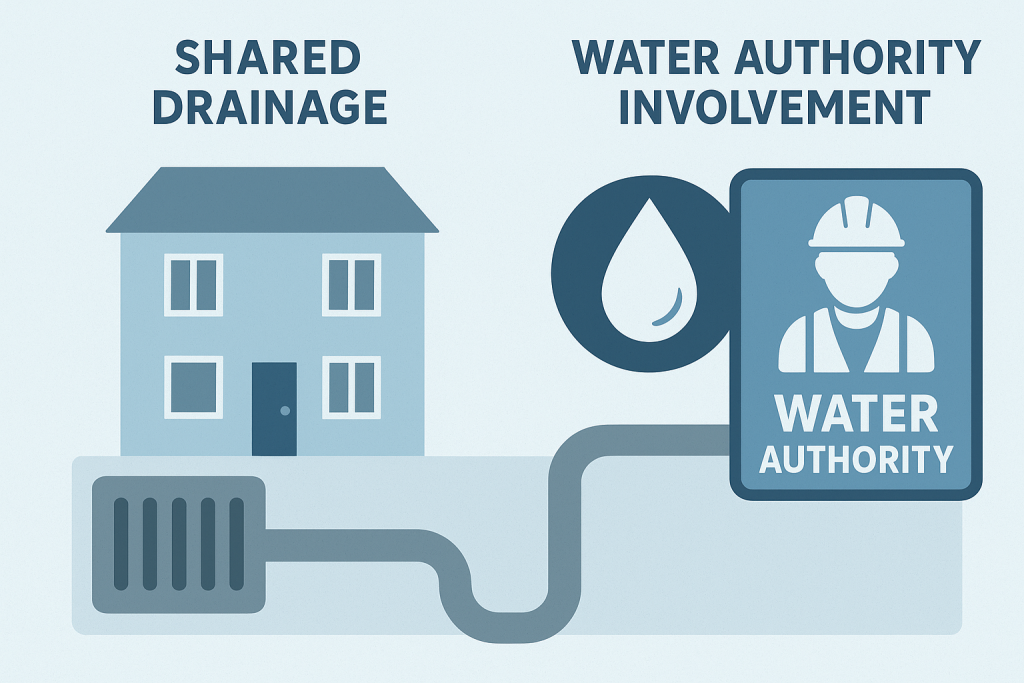
Rental properties often connect to shared drainage systems, adding another layer to responsibility questions. Understanding these systems helps determine who actually pays for blocked drain repairs.
Water authority responsibilities:
Local water authorities maintain all shared drainage systems, including private property connections in many cases. If your drainage problem affects multiple properties or occurs in shared pipes, the water authority might be responsible regardless of the blockage cause.
Identifying shared systems:
Flats almost always have shared drainage. Houses might share drainage with neighbouring properties, particularly in older developments or converted buildings. Our CCTV surveys can trace your drainage connections and identify shared sections.
Freeholder involvement:
In flat developments, freeholders typically manage drainage systems serving multiple units. Individual leaseholders rarely have responsibility for shared pipes, external drainage, or major system components.
We work regularly with water authorities, freeholders, and property management companies. Our detailed surveys help identify exactly which sections of drainage systems fall under different responsibilities, preventing unnecessary costs for landlords and tenants.
Frequently asked questions
Does my landlord pay for blocked drains caused by normal use?
Yes, landlords are responsible for drainage problems resulting from normal household usage, structural issues, or pre-existing problems. However, tenants pay for blockages caused by misuse, such as flushing inappropriate items down toilets or pouring grease down sinks.
What counts as drain misuse as part of a tenancy agreement?
Drain misuse includes flushing wet wipes, sanitary products, cotton buds, cat litter, or excessive amounts of toilet paper. Kitchen sink misuse involves pouring fats, oils, grease, or large amounts of food scraps down drains. Essentially, anything beyond normal toilet use and reasonable washing-up constitutes potential misuse.
How can I prove whether a blockage is the landlord’s or tenant’s responsibility?
CCTV drain surveys provide definitive evidence about blockage causes. These investigations reveal whether problems result from structural issues, tree roots, pipe deterioration (landlord responsibility), or inappropriate items and tenant misuse (tenant responsibility). Video evidence prevents disputes and ensures fair cost allocation.
Who pays if tree roots block the drains?
Tree root blockages are typically the landlord’s responsibility, as they represent structural maintenance issues. However, if tenants planted trees too close to drainage systems or damaged pipes allowing root ingress, they might bear some responsibility. Most tree root problems develop over years and predate current tenancies.
What should I do if my landlord refuses to pay for drain unblocking?
First, gather evidence about the blockage cause – CCTV surveys provide definitive proof. If the problem results from structural issues or normal wear and tear, landlords are legally responsible under the Landlord and Tenant Act 1985. Consider contacting your local authority or seeking legal advice if landlords continue refusing reasonable requests.
Can landlords charge tenants for emergency drainage call-outs?
Only if the blockage results from tenant misuse or negligence. Landlords cannot charge tenants for problems arising from normal usage, pre-existing conditions, or structural issues. Emergency call-out charges should reflect the actual problem cause, not just who initiated the service call.
How often should rental property drains be professionally cleaned?
Annual professional drainage maintenance prevents most blockage problems. However, frequency depends on property age, drainage system condition, and usage levels. Properties with large families or known drainage issues might benefit from more frequent attention, while low-usage properties might need less frequent maintenance.
What’s the difference between internal and external drainage responsibility?
Internal drainage (within the property boundary) is typically the landlord’s responsibility for structural maintenance but may become tenant responsibility if misused. External drainage (beyond property boundaries) is usually water authority responsibility, particularly for shared systems. Property deeds and local authority records clarify specific boundaries.
Taking action when drains demand attention
Understanding who pays for blocked drains in rental properties doesn’t have to drain your patience or your wallet. The key lies in identifying the root cause of the problem – quite literally in many cases involving tree roots.
Remember, landlords bear responsibility for structural issues, normal wear and tear, and maintaining drainage systems under the Landlord and Tenant Act 1985. Tenants become responsible when blockages result from misuse or negligence. However, determining the actual cause often requires professional investigation rather than guesswork.
The most effective approach combines prevention with prompt professional response when problems occur. Whether you’re a tenant wanting to avoid unexpected bills or a landlord protecting your property investment, understanding your drainage system’s condition provides invaluable peace of mind.
Ready to resolve your drainage concerns?
At Any Drains Direct, we’ve built our reputation on providing transparent, professional drainage services that benefit both landlords and tenants. Our comprehensive investigations, rapid emergency response, and commitment to fair pricing ensure that you pay only for what you’re actually responsible for.
Don’t let drainage disputes become a source of ongoing stress. Whether you need emergency unblocking, preventive maintenance, or detailed surveys to establish system condition, our experienced team delivers solutions with complete transparency.
Contact Any Drains Direct today for expert advice, rapid response, and transparent pricing. We provide free quotes, guarantee our work, and respond to emergencies within 90 minutes. Let us handle the messy work while you get back to more important things.
 01732 667 688
01732 667 688


